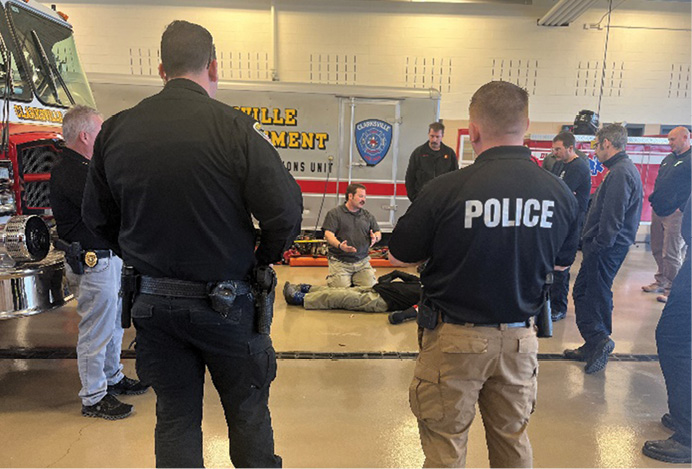BY MARK LITWINKO
As public safety responders, we should not be surprised when we find ourselves working in increasingly complex and challenging environments. Collaboration and innovation have become the cornerstones of an effective response in this ever-evolving public safety landscape. Fire, police, emergency medical services (EMS), and other agencies increasingly recognize the importance of working together to ensure the safety and well-being of their communities.
Tactical Emergency Casualty Care for High-Threat Environments
And as public safety agencies embrace a more unified approach to their missions, they recognize that the challenges they encounter often transcend their respective domains’ boundaries. With ever-increasing active threats, including active shootings, terrorism, rioting, and other violent incidents, the collaboration between all public safety agencies for active threat response has become more critical than ever. First responders must integrate their respective specialties and tactics in cohesive and coordinated efforts to mitigate and respond to these threats jointly and effectively.
The synergy created by this collaboration enhances their effectiveness and ultimately strengthens the fabric of our society. But this integration requires more than just taking a pen to paper to set up new standard operating procedures or guidelines. It takes real, in-person, hands-on training (photo 1). Just like a sports team, public safety agencies must practice to fully understand how we come together as a public safety team to prepare for an act of violence. As the old saying goes: “A plan never practiced is simply just a theory.”

1. Photos by author.
Key Deficiencies
After-action reports from significant incidents often indicate key deficiencies, and the three most frequently identified are as follows:
- No preexisting plan or training for joint agency responses.
- Communication breakdown.
- Lack of unified command.
Collaborative public safety initiatives that emphasize interagency training for an active threat response are critical. Active threat incidents require swift and coordinated responses, with every second counting in the effort to save lives and complete the mission. These incidents are chaotic and dangerous, and no single agency can handle them alone. Here’s an overview of ways to avoid such challenges in the future.
Joint Agency Responses
The expertise of various agencies will be required to handle these situations effectively, and responders must be prepared to act as a unified front. I often find that public safety agencies that implement interagency training exercises and initiatives foster a sense of unity. This enables responders to be more effective in tackling complex issues. These interagency training exercises enhance coordination and collaboration, ensuring that first responders can work together seamlessly during the complexity of an active threat incident. Having responders from different disciplines training side by side gives them a chance to develop deeper understandings of each other’s roles and responsibilities as well as their processes and challenges (photo 2).

2.
In some cases, first responders engage in cross-training with other agencies to acquire basic skills and knowledge from other disciplines. This is easily seen in tactical emergency medical services (TEMS) teams, where emergency medical personnel are cross-trained with special weapons and tactics teams (SWAT) to provide care in hot zones, during tactical law enforcement operations where traditional EMS would not operate.
Another example is within the rescue task force (RTF) concept, where firefighters may learn about basic law enforcement techniques, while police officers may receive training in basic trauma care. This cross-training enhances responders’ versatility and enables them to provide additional assistance when needed.
Communication
Effective communication is the lifeline of public safety, which is even more critical for teams initiating unified public safety responses. Such communication includes sharing critical information, coordinating responses during emergencies, and developing shared communications protocols to ensure all responders are on the same page.
Communication and coordination are critical components in ensuring the success of the mission and the safety of both the responders and victims. Communication during interagency training scenarios should be clear and timely, providing responders with a comprehensive understanding of the mission and training goals. Effective communication during training exercises will directly translate into real-world incidents. It helps responders make informed decisions so they can adapt their response strategies accordingly and ultimately allows for a well-coordinated and organized response. This prevents confusion and conflicting actions (photo 3).

3.
Command Operations
In crisis management, particularly in high-stress situations like active threat incidents, the unification of command operations from all responding agencies is critical. Command officers from different agencies working together under a single unified structure allows for an enhanced response. This directly contributes to saving lives and minimizing public harm.
Each agency involved in the active threat response brings unique resources and expertise to the scene. A unified command facilitates coordinating and allocating these resources, ultimately optimizing their use to manage the incident more efficiently. This efficiency brings all agencies together and ensures that resources are deployed where they are most needed.
The concept of a unified approach in public safety has emerged as a powerful solution to enhanced responses in times of crisis. As first responders, we all share a deep commitment to public safety regardless of our disciplines. While our day-to-day duties differ significantly, our common goal is to protect and serve the community. A unified response enhances our effectiveness as first responders and builds trust and confidence within our community. The challenges of responding to active threat incidents are complex and dynamic. However, by collaborating, cross-training, standardizing protocols, and effectively communicating, public safety agencies and first responders will be better equipped to respond to high-risk situations and protect our communities.
Mark Litwinko is a 19-year veteran with the Fort Wayne (IN) Fire Department and serves as an investigator and commissioned law enforcement officer for the Arson Investigations Division. In 2013, Litwinko oversaw the design, implementation, and training of the FWFD/FWPD Rescue Task Force program in response to high-threat/active-assailant incidents, making them the first agencies in the state of Indiana to have a unified response protocol for active threat incidents. He now routinely instructs public safety agencies throughout the Midwest on the implementation of rescue task force operations.

